Having run inside, fleeing from the sub zero temperatures outside today, I spent the day updating our ArcGIS tree map with all the newly planted trees this year, as well as our removals. Seems like a good time to point towards the Campus Tree Map page, or go/treemap. The latest map contains all the trees we individually manage on campus, nearly 2500. Maybe if the cold spell lasts we’ll come up with a smartphone compatible tour…
Landscape
Blind Sidewalk
Landscape architects sometimes speak of ‘desire paths’-a phrase that means exactly like it sounds. Laying out sidewalks, driveways, or trails is considerably harder than it looks. A budding architect can either be a hero for guessing exactly where pedestrians want to walk, or a goat for taking an urban mentality and assuming people will use the sidewalk regardless of location.
Try as we might, the Middlebury campus is full of desire lines. Some are an easy fix. Two new sidewalks cut across the top of the Atwater quad based on dirt paths that had appeared post-construction based on pedestrian traffic flow. One that couldn’t be done, a dirt path from the Johnson Parking lot to Atwater dining, we tried to block with trees and shrubs, but the desire remains unabated. Another one that concerns us is a dirt path from Battell Beach heading toward Milliken Hall. This cuts in a straight line up slope, and is becoming so worn down that it may soon start to erode.
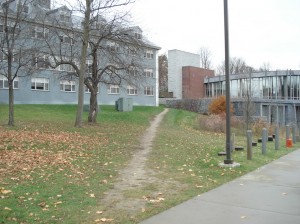
A new desire path appeared after the renovation of The Axinn Center at Starr Library. The northeast corner of the building, down by Route 30, houses several large classrooms, and students cut across the quad from the Main library down to that corner.
Not that we blame the pedestrians. It’s cold here. Getting from point A to point B as quickly as possible makes campus life a little more tolerable in January and February. It’s a pretty obvious place for a walk, but the problem is the other walks in the space.
Before my time, the walk ways were redone, and came out beautiful. This is landscape architecture at it’s best. Gently curving paths arc across the space, connecting the buildings that surround the quad. The brilliance of the plan is the fact that they work. In colder climes like ours usually corners are cut, curves straightened, and shortcuts abound. The desire line from the library to that corner was, as expected, straight, and pouring this as a walk would break the beautiful rhythm of the rest of the walkways.
Then, after one winter storm, the path was beaten through the snow, this time gently arching around some trees, eventually meeting the walkway to the library.
With this proof of concept, we were off and running. Last summer we went out to the quad with surveyor flags, and marked a potential route. Some language school students became willing test subjects, and we tweaked the lines for an hour or so until it flowed right.
The other, even more subtle brilliance of the walkway layout in the library quad is the way the sidewalks are blind, hidden from view. I bet few people have noticed this, but a picture makes it obvious.
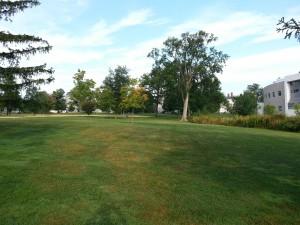
Looking up from Route 30, the quad appears to a large expanse of lawn, unbroken by walkways. The art is in the subtle placement of the walkways. All of them are slightly built up on the route 30 side, and pitch towards Old Chapel Road. Leaning the other way, the flat expanse of the walk would be visible, but the design at present allows them to be blind, not seen from the road. Obviously that couldn’t be done had the road been higher than the quad, but geology and geography was on our side this time.
The new walk was tricky to match this effect. Its placement across the quad required some elevation of the surrounding area, as well as some grading to continue the natural water flow across the lawn. Had this been interrupted the sidewalk would pool water and turn into an icy mess.
Arbor Day 2013
It’s been a gorgeous spring, and we’re celebrating with a huge Arbor Day celebration. Plan on joining us May 14th, details below. But in the meantime…
love a tree? share the love. send us photos, poems, and other art about your favorite campus tree. Submit a photo, or post on twitter with #middarborday. submit by may 10 to have your tree featured in the arbor day tree-k race! Either go twitter (@middland) or send to tparsons (at) middlebury.edu to submit. Prizes, fame, fortune, and good tree karma await. And the winning trees will become the basis of the second annual Tree-K race around campus (run 5-K,, and learn the names of 5 of the trees along the route to win) A kid’s race will be held as well. Winners receive gift certificates to the Grille.
The days events will be as follows:
Campus Tree Tour-join us for a walk around campus and learn about some of our woody friends. The tour starts at the McCullough Plaza at 2 PM, and wends its way through campus until about 3:30, when we will end up north of Battell Hall, where we-
Plant a Tree– a whole bunch of trees will be awaiting your tender loving care to be planted north of Battell Hall and in between Allen and Wright Theater. If you’ve never planted a tree this is something you should do-it will still be here for all of your reunions, like the rest of your old friends you’re eagerly awaiting to see. Afterwords, you can run or watch the-
Tree K Race-run about a 5-K loop around campus to all the various favorite trees nominated by the Middlebury campus community. Winners will receive prizes, and all kids will as well. Not too strenuous, as you’ll need to save strength for-
Food, music, and ice cream-We’ll be on the Atwater plaza, with a cookout by Grille Catering using local foods, ice cream, and listen to music by Will Cuneo and Rita Pfeiffer. Enjoy the sunshine for an hour or two before heading back inside to study for finals. A huge thank you to the Environmental Council for funding us!
So spread the word, let your neighbors know, and come celebrate our campus forest.
Bark Mulch
June may smell like roses, May smells like Lily of the Valley in my mind, but spring, sweet, sweet spring, smells like bark mulch.
Like many things in Horticulture, mulching really isn’t for the plants, but for us. Meant to imitate the look and ecosystem of a forest floor, mulch does neither, but it is not completely benefit free either. Mulch can help regulate soil temperatures in summer and winter, helps retain soil moisture, and can also help keep weeds out of the space. A little can go a long way, though, and as we’ve learned here, mulch is not something to just put down and forget.
Mulch can be a variety of materials, but let’s focus on tree bark and wood chips. On campus we use a double ground spruce/hemlock mix locally made in Newport, but that’s really all about looks. I used to be one of those people selling bark mulch, and so would steer people away from using (free) wood chips, but I’ve since recanted. The handy excuse I would use is that the as chips break down through normal soil processes they steal nutrients from the soil, and therefore the plants, but this has not been supported by research. And in fact a good mixed load of chips, twigs, leaves, and needles from the back of a typical arborist’s truck seems to imitate the duff of a forest floor nicely, and is becoming the preferred mulch for some. If you are interested, some good reading on this is published by Dr. Linda Chalker-Scott of Washington State University.
I used to say 3” of bark mulch was the right depth. I now think that’s too much and 2” is probably fine. Mulch too deep can actually inhibit water from reaching down to the roots, and/ or cause shallow rooting of trees. This is easy to see either by a white fungus growing throughout the mulch, or by roots growing right through the mulch.
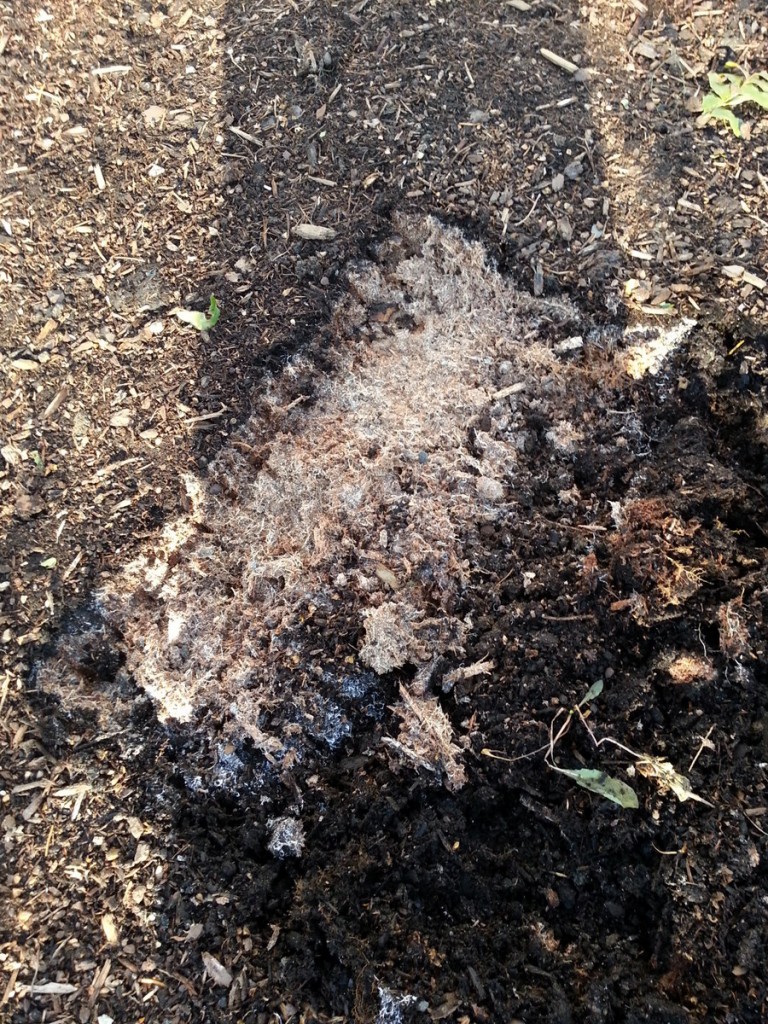
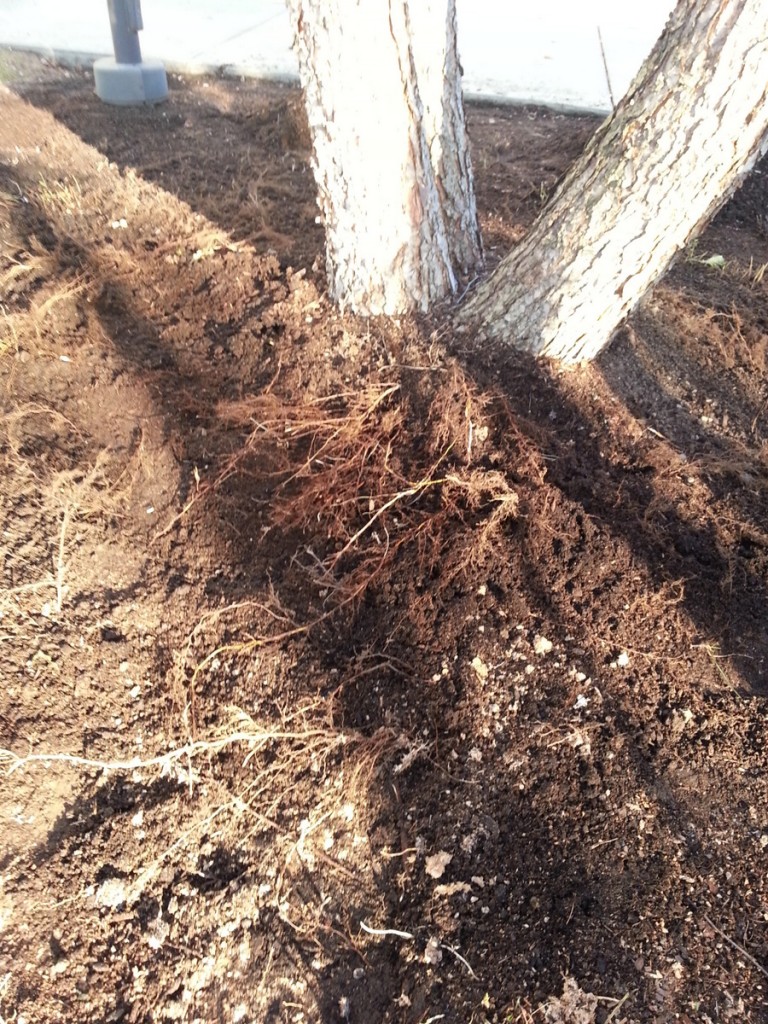
Too much of a finely shredded mulch can also decrease oxygen to the soil and roots. Unlike leaves, which make oxygen, roots require oxygen for respiration, and a thick layer of mulch will prevent good gas exchange between the soil and the atmosphere. The white fungus seen above has the added nastiness of turning the mulch hydrophobic, or water repellant. The mulch not only will not allow water to pass through, but will actively repel water right from the top, and let it run off.
Another thing I ignored in the past was the edict of not placing mulch against the trunk of the tree. I’d personally never seen any harm or problems by this practice, and being a busy landscaper, never took the time to push back the couple inch ring of bark mulch from around the trunk.
A gingko tree has recently proven me wrong. We’d noticed this tree declining for several years, and given the pattern of decline, assumed it was something wrong with the roots, like compaction or too abundant moisture. Closer inspection at the root flare (the most critical part of any tree) showed a ring of decay circling the entire tree, preventing all the nutrients and some of the water from its proper flow within the cambial layer. This decay was undoubtedly caused by the mulch against the trunk, and can be directly implicated in the death of the tree.
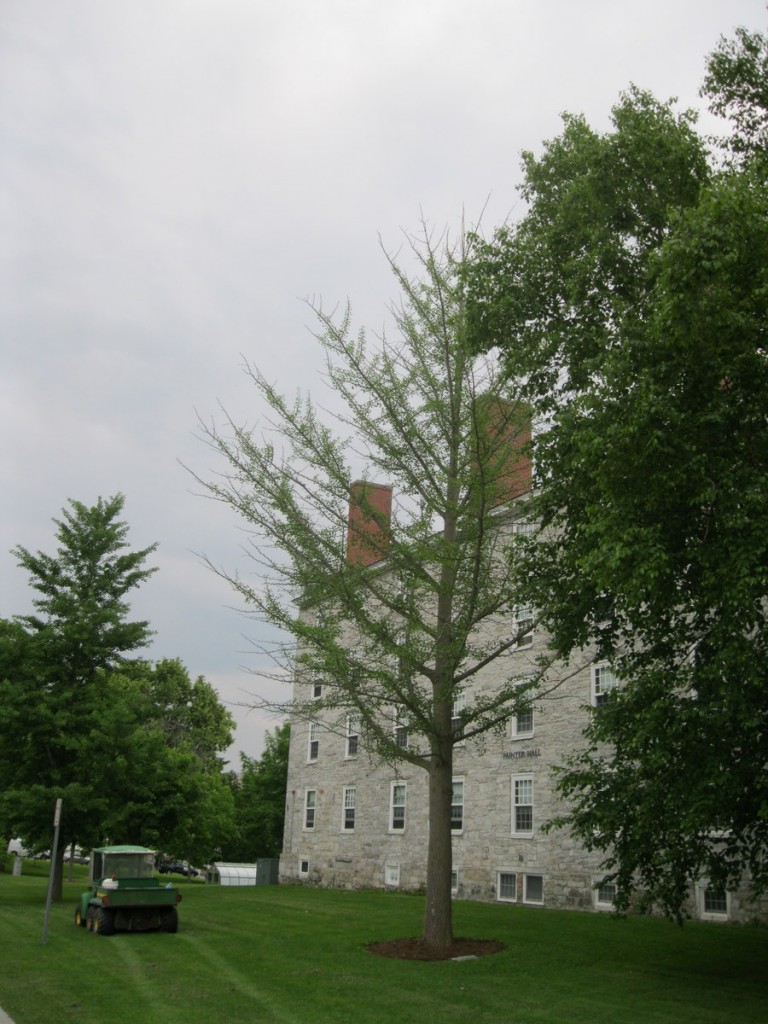
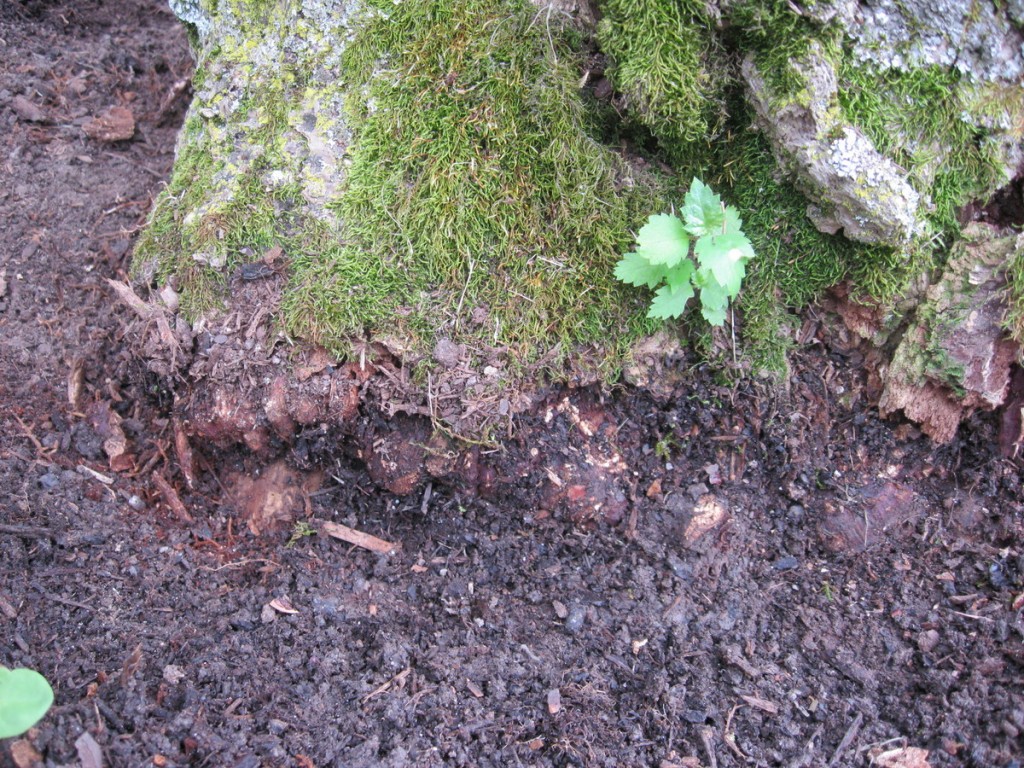
Even if the mulch did not cause the bark to rot away, the constant moisture against the trunk, like the roots in the example above, decrease gas exchange. The trunk needs oxygen much like the roots, and can’t do this when it is constantly moist from mulch.
So my new mulching recommendations are these. Mulch is good, about 2”, real shredded bark if you can afford it, wood chips if they are free. Avoid the dyed mulch, which just plain looks tacky. Don’t blindly put a new ½” to 1” of mulch on top of last years’, better to dig down in the old mulch to look and see what is going on. Maybe stir the mulch up some, break up any hydrophobic layers, or add some compost for a biological kick in the pants to break down the existing mulch and closer imitate a forest floor.
And stone pebbles for mulch? Only in a zen garden, please.
My Latest Heartbreak
No, not the song by the 22-20’s.
The plant vandalism on campus continues. We’re on year four, and I’ve been trying to document all the cases. The tally stands at 62 incidents in the last four years, 10 in 2009-2010, 25 in 2010-2011, 9 in 2011-2012, and 18 so far this school year.
Will Henriques wrote an excellent article for The Middlebury Campus on our spate of tree and plant vandalism, after interviewing both myself and Brian Marland, a student in my winter term course who wrote a term paper on tree vandalism. The thrust of Brian’s paper was how plant vandalism is an inherently violent act, and how this is more than likely related to alcohol consumption. Not even consumption by the vandals. Studies he found show an increase in violent tendencies by people not even drinking, but merely in the presence of alcohol or alcohol advertising. Brian writes, “aggression is no longer viewed as an unwanted result of drinking, but instead is seen as an expected condition. Therefore, students may be committing vandalism in order to meet these expectations and produce a reputation among their peers. When surrounded by a drinking culture, these expectations of aggression may fuel behavior that would not occur otherwise among these college students…While living in an environment where alcohol consumption on the weekends is common such as a dorm, a college student does not even need to consume alcohol to be subject to the aggressive thoughts and behaviors that may follow alcohol cues such as a beer bottle. This revelation is instrumental in understanding the acts of tree vandalism that plague the Middlebury College campus. After drinking, many students travel in groups to parties in other locations, and even if a person in this group had not been drinking, their behavior will still be subject to aggressiveness from exposure to alcohol cues. They will be much less likely to interfere with or report senseless acts of vandalism in this heightened state of aggression. Therefore, in an environment of alcohol consumption on a college campus, all students exposed to the environment may be suspect to increased aggression.”
I’ve written about the violence against the trees in the past, and we continue to see the same acts again this school year. The classic example would be an elm tree planted 2 years ago for the Atwater landscape project, rocked back and forth, and the 300 lb. root ball pulled up out of the ground and left on top for an entire weekend.
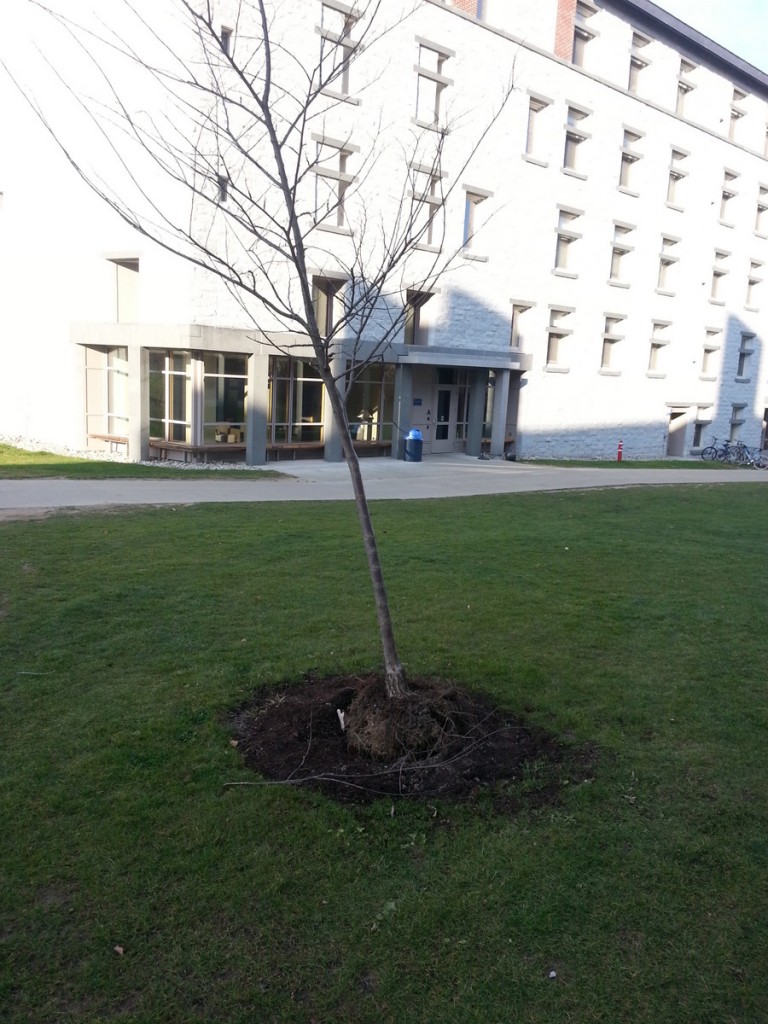
Sadly, this wasn’t the only tree torn from the ground this year-two more that were planted last spring were pulled during winter term.
As Will’s article alluded to, and Brian summarized well in his paper, the damage seems to be focused not necessarily around party locations (little damage is seen in Ridgeline, for example), but seems to be on pathways to and from these locations. I recently mapped the locations of the incidents for the last four years, and have included it below.
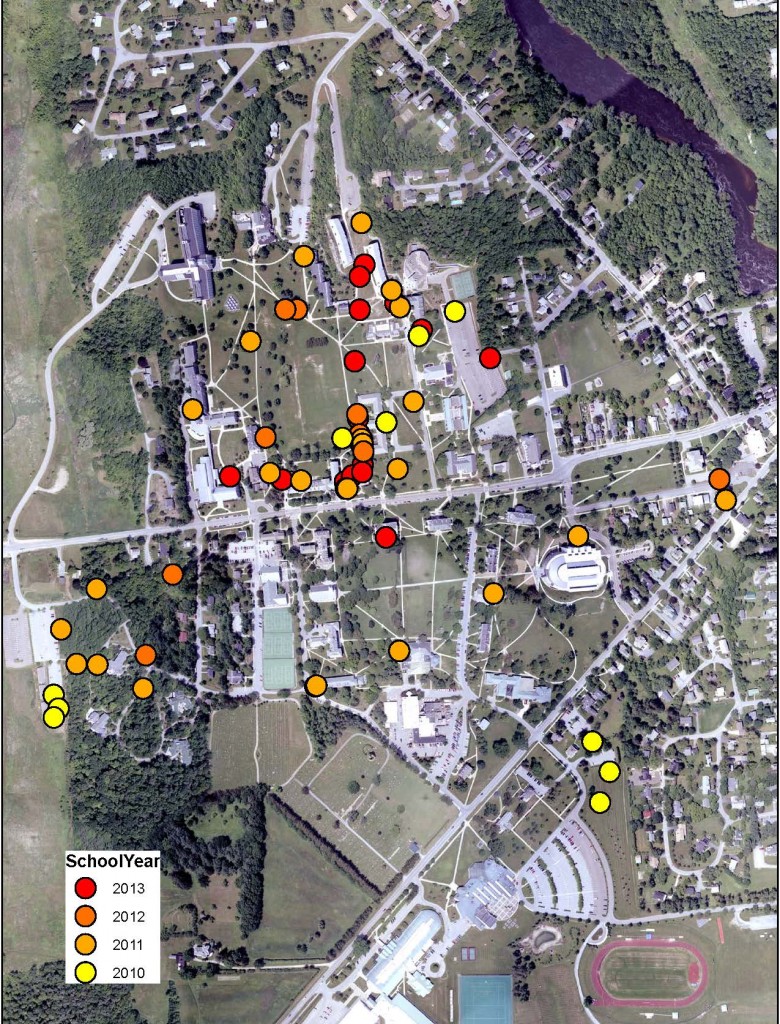
Click for larger size
I continue to struggle with solutions. Some communities post signs next to the damage. I hestitate, thinking about how within the next year I’ll be going on school tours as a parent. Surely the article in the Campus is a great start, as will be our annual tree planting for Arbor Day (May 14, mark your calendars now). We’re a small community, we have to take care of each other, and that would include our campus forest as well.
Cultivating Hope, Wisdom, Compassion, and a Tree
Nature can teach us many things. Life, death, love. And Hope, Wisdom, and Compassion. How appropriate the 14th Dalai Lama uses ‘cultivating’, the act of promoting growth, to describe his wish for the dissemination of his main tenants for the human race to strive for.
Sogyal Rinpoche, the Buddist author of the Tibetan Book of Living and Dying, writes of trees:
Think of a tree. When you think of a tree, you tend to think of a distinctly defined object. But when you look at it more closely, you will see that it has no independent existence. When you contemplate it, you will find that it dissolves into an extremely subtle net of relationships that stretch across the universe. The rain that falls on its leaves, the wind that sways it, the soil that nourishes and sustains it all the seasons form part of the tree. As you think about the tree more and more you will discover that everything in the universe helps make the tree what it is; that it cannot be isolated from anything else and at every moment its nature is subtly changing.
A Bur Oak is planted next to the Garden of the Seasons just south of the main library, waiting to be blessed by His Holiness the Dalai Lama. Think about this tree, as it grows tall and wide, its roots spreading far across the quad joining its companions, and be reminded that like a tree, we all depend upon each other as well: we all share a subtle net of relationships. Let the small oak show our hope, our faith in growth and long life, as our grandchildren will see the large tree. And let it teach us wisdom, like the timeless ‘wise old oak’ of our childhood stories, and learn from it compassion, as no tree stands alone.
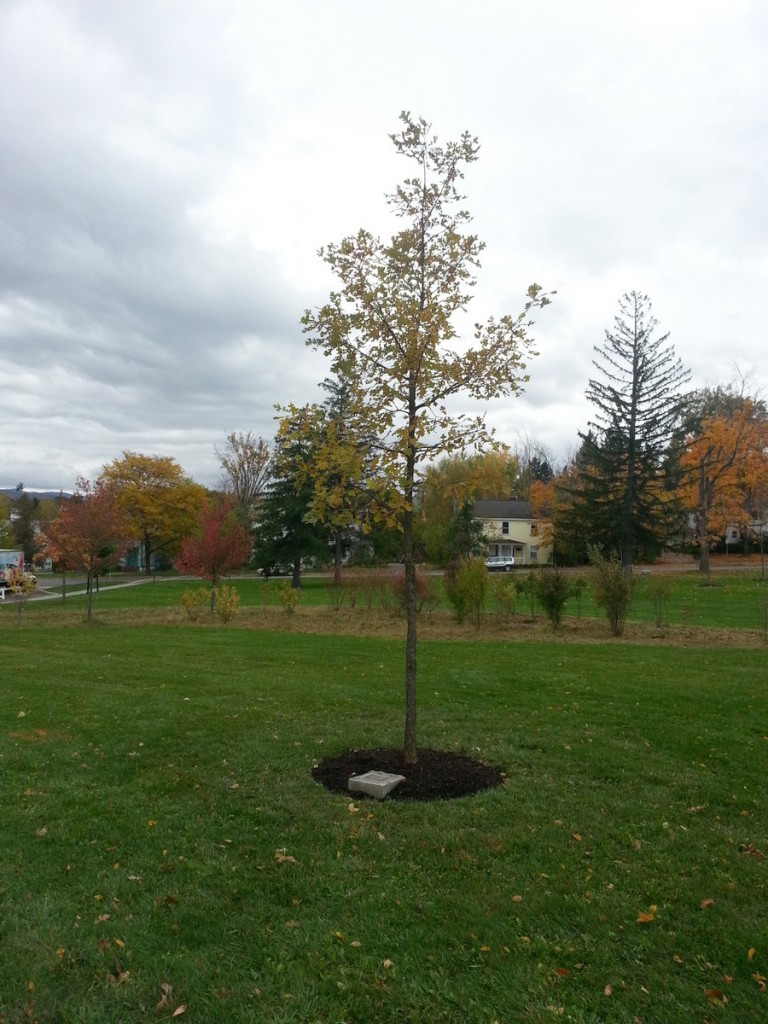
Watering
Pick up any plant biology book, and they consistently list the three macro nutrients all plants need as N, P, and K, the chemical symbols for Nitrogen, Potassium, and Phosphorus. But really, what we share with plants is a need for ‘macro’ macro nutrients, something so profoundly necessary that the books don’t even feel the need to list them, and they form the backbone of all life. We’re talking about C, H, and O, or Carbon, Hydrogen, and Oxygen.
The carbon and the oxygen are easy, the plants are getting that in the air we breathe. It’s the Hydrogen that’s been stressing me out lately. Plants obtain it solely from water, through photosynthesis. I always remember my snide remarks in the retail garden center world, when a customer would ask me what kind of fertilizer to buy with their new purchases. For the most part, I’d tell them the single greatest thing they could do would be to water.
How much? It’s a good question with no real definitive answer. I remember from who knows where that gardens in the northeast need about 1/2″ of rain a week in the growing season, and an article on strawberry production I found says about the same (actually .63″). Trees need quite a bit more, though, as they have much more extensive roots throughout the soil horizon. Plan on 2″ of rain a week. I found a handy online calculator to do the math, but here’s a quick answer. A newly planted tree with about a 2″ trunk, should have a 5′ x 5′ zone watered around it, so that’s about 30 gallons, pretending to be a 2″ rain.
Sounds a little high, but the wild and woolly world of plants is never easy. Last year we were averaging 4″ of rain a month, and we didn’t have to do any supplemental watering. On cloudy days plants don’t transpire, or lose water, at as great a clip, so maybe last year it was fine.
Or not. We’re running around like chickens with our heads cut off right now, watering every tree we’ve planted for the last 3 years. (that’s a lot) All of our recently planted trees are showing drought stress, and I’m wondering if I hadn’t watered enough in the last 2 wet years to well establish the trees. When watering, it is best to water a lot all at once, so that the roots have ample moisture and can grow long and deep. Too little water, and the tree keeps its roots near the surface, where the water is, and this makes it less drought resistant in the long run.
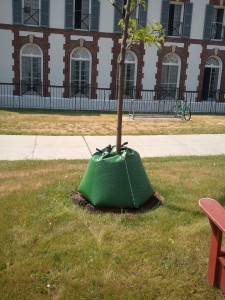
We water all trees with 40-50 gallons of water about every 2 weeks. We use two gator bags zipped together, and they drain over the course of about a day. We hand water any tree we missed, and then gator bag it. In this heat and drought, I’d like to water weekly, but I’ve been checking the ground around the trees, and I think we’re keeping up.
Another good trick I learned once when hand watering is to watch the ground as it absorbs water from the hose. I think this is the one of the Eliot Coleman gardening books, but I loaned my copy out and now it’s gone. Once the ground starts to get saturated, the top gets glossy. Take the hose off that spot, and the glossiness will disappear. If you can count to 3 before the glossiness is gone, the ground is moist enough.
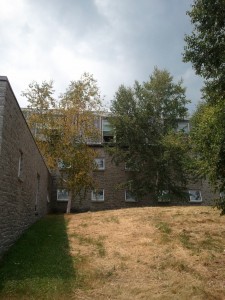
identifying drought stress in plants can be tricky, especially in herbaceous plants like annuals and perennials. Woody plants are easier. The inner leaves of the tree turn yellow and fall off. I find this remarkable. It isn’t like trees have brains, but here they are smart enough to drop the inner, less efficient leaves, to conserve its precious water for the maximally producing outer leaves. By the time your plants are showing symptoms of drought, obviously much damage is done. Plants are pretty hardy, so even with serious problems the tree will probably be fine.
Arbor Day 2012
I measure my life in tree plantings.
Every time I come home from the Burlington airport, I drive down Dorset street in South Burlington and visit a Blue spruce I planted on a landscape job my first year out of college, 1989. It’s over 40 feet tall now, making me old.
A paperbark maple in front of my mom’s house in Connecticut is a lot smaller, but slows traffic down on the road in it’s awesomeness. A pair of honeylocust in front of a local church down there planted at my very first landscaping job now towers and dominates the little front yard. A Kentucky Coffeebean tree in my side yard in Weybridge planted when we moved in about 11 years ago is now starting to look like an actual tree, the trunk about 4″ now (it started small, I’m cheap).
Middlebury College has once again been certified as a Tree Campus by the Arbor Day Foundation, and the landscape department is celebrating by planting trees (naturally). Come join us Friday afternoon from about 1-4 just north of Battell as we plant 5 large shade trees. The holes will be pre-dug, so it won’t be too much work. (Sorry, can’t let you run the backhoe, I would if I could). Here’s your chance to make a mark on the Middlebury campus, and always have a friend to come visit when you return to paradise.
Or maybe we can call it my open office hours, no appointment necessary. Visits need not be limited to 15 minutes.
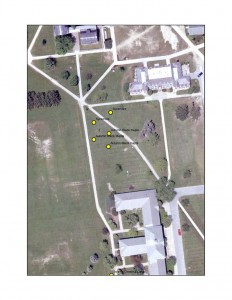
A New Class Tree
What we call a Class Tree on campus is a tree commemorating a graduated class, typically christened with a ceremony during reunion, such as on a 10th, 25th, or even greater. Our department was recently asked to pick a potential class tree for the upcoming reunion, and we’re more than happy to help. Traditionally we use a tree we’ve already planted in the recent past, and only ask that the class pay for the stone and plaque. This way we know the tree is already well established, so will live a good long time.
Trees connect us in many ways—through life, shade, a place to lean and sit under. Class trees are connected memories, bundles not of neurons and blood, but marking with rings and twigs the experiences of four years at Middlebury, a snapshot in time. Looking at class tree makes you think of your time in Middlebury, and your life during the time of that class.
Even before the discussion of where the tree would be and what type, I’d already picked one I thought would be perfect, and the request of having a Vermont Maple aligned perfectly. It’s a Sugar maple, grown by my good friend V.J. Comai at the South 40 nursery in Charlotte, and was planted 3 years ago.
My first summer here I was out in front of the Davis Family Library mapping the trees in the Library Quad. Collectively some of our oldest trees on campus, they are also the most stressed, with years of soil compaction wreaking havoc on fragile root systems. A professor came up to me, to this day I don’t know who, but he undoubtedly taught some of the students in this class. He asked what I was doing.
I explained how I was mapping trees, assessing health and measuring, and he asked if there were plans to plant more trees in this quad. I said most certainly, and showed him some of the weaker old trees nearby, and told him how it was much easier to remove a dying tree if the replacement tree was planted nearby and already well established. He then asked if I was going to keep the original line of trees, and fill some of the holes.
I had no idea what he was talking about. The trees in this quad are scattershot throughout, in random locations in between the uneven lawn shapes formed by the sidewalks. When the new library was constructed, many of the sidewalks were re-done in the library quad. At present, they are graceful swooping curves connecting the various destinations, such as Old Chapel, the library, Emma Willard, and Warner Science and Starr Library.
He points, and I look, and then finally see how many of the trees in the quad aren’t random, but demark a sidewalk long gone, connecting the south (front) door of Warner to the north (again front) door of what we now call Starr/Axinn. The old sugar maples lined the walk, and reading the landscape history, it was clear where some trees were removed, and needed to be replaced. The line is like a hidden Easter egg, a subtle reminder in the landscape of the past that many of us here don’t even know, a past the graduated class looking for a new tree took for granted as they walked on the now removed sidewalk from class to library.
I’ll be placing this plaque in the ground, looking down the row of trees, and thinking about what I was doing while these students were walking the long gone sidewalk. I was failing naptime in preschool.
My preschool was in a church basement, with a painted concrete floor reminiscent of the tile in the church upstairs, but harder, colder. Naptime means we bring out our blankets mom brought the first day of the year, and we place them out in neat rows, lay down for a half hour or so, and probably give the workers there a much needed break. My blanket had developed a hole, and my mom brought it home the previous night, sewn a patch over, and hung it back up on the rack as she dropped me off.
I lay my blanket out on the floor. There’s the patch I’m seeing for the first time, a large, black, hairy spider right where the hole used to be.
Screaming, tears, running, and no nap. For anybody.
Season Creep
Everybody has their own phenologies, their own timing of spring. First day the snow shovels get put away (unused in my driveway at all this year, I might add), first day of working without long johns on, or maybe the first day of wearing shorts. I’ve always dreamed as a horticulturist of keeping a journal, tracking of events throughout the years such as first frost, peepers in the pond, first robin at the feeder. Yesterday I realized I sorta had one, and that I hadn’t posted to it in a while. So here I am…
One of my harbingers of spring is the opening of forsythia. It’s a plant I grew up with in our backyard, and the bright yellow flowers more than anything else speak spring to my weary winter frame. After arriving to work yesterday I saw the ‘Vermont Sun’ Forsythia in bloom next to the service building parking lot. Early. I first wrote about this hedge of Forsythia when in bloom on April 13, 2009, and wrote about it again in 2010 when it way 11 days earlier in bloom, on April 4. For the record, the bloom date this year was yesterday, March 20. Peepers were in my pond Monday the 19th of March, a blog post on them in 2010 was April 2.
Phenology, not brought to you by the letter “F”, comes from the greek phaino, meaning to show or appear. It’s the study of recurring life cycles of what is around us, the timing of insects, plants, mammals, and the relationship of time to weather and climate. There is even a USA National Phenology Network, using volunteers across the nation to study these cycles. A great example is the Cloned Plants Project, a partnership with the aforementioned USA NPN and the National Weather Service, where clones of either a lilac or flowering dogwood are planted in an observer’s yard and bloom times noted throughout the years.
Obviously, this is wonderful data for global warming. More inputs than air temperature factor into when trees leaf out in the spring. Daylength certainly plays a part, as well as moisture conditions the previous fall, and amount of cold temperatures in the winter. But air temperature is the biggie. A study of oak leaf emergence in England since 1947 has indicated that a 1 degree rise in global temperature is associated with a 7 day earlier tree leafing. This is called Season Creep, and scientists point to this as one of the first effects of global warming that we can actually see in the present, with most of the other detrimental effects taking place in the future.
So where does this put us right now? I’ve been getting many questions on if this early spring will hurt the trees or landscape, and the best answer isn’t cut and dry. The worry is a late frost or freeze after the buds have opened, or shoots emerged from the ground. Short answer? The plants will be fine.Trees losing their first set of leaves can regrow new ones from secondary buds. Like beer on a worknight, it isn’t something to make a habit, but once in a while it isn’t going to hurt anything. And bulbs and perennials emerging from the ground know just when it is safe to come out-a frost never seems to bother them.
The impact of a freeze will be bad for us humans. For example, apples bloom before the leaves emerge, so should they bloom and get pollinated, a late freeze will destroy most of the crop for the year. There are no secondary buds for flowers.
The mild and early spring will cause other problems as well. Those suffering from allergies are miserable all the sooner. And the short, mild winter did nothing to mitigate the deer tick population, so extra care should be taken. If you are interested in tracking the spring and summer phenologically, I can’t speak highly enough of the UMass Landscape Message, posted weekly.

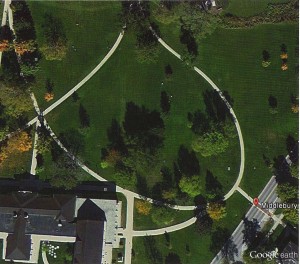
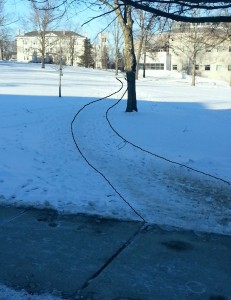
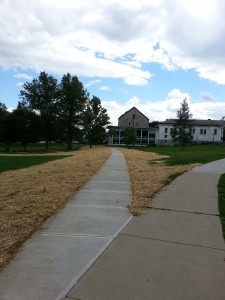
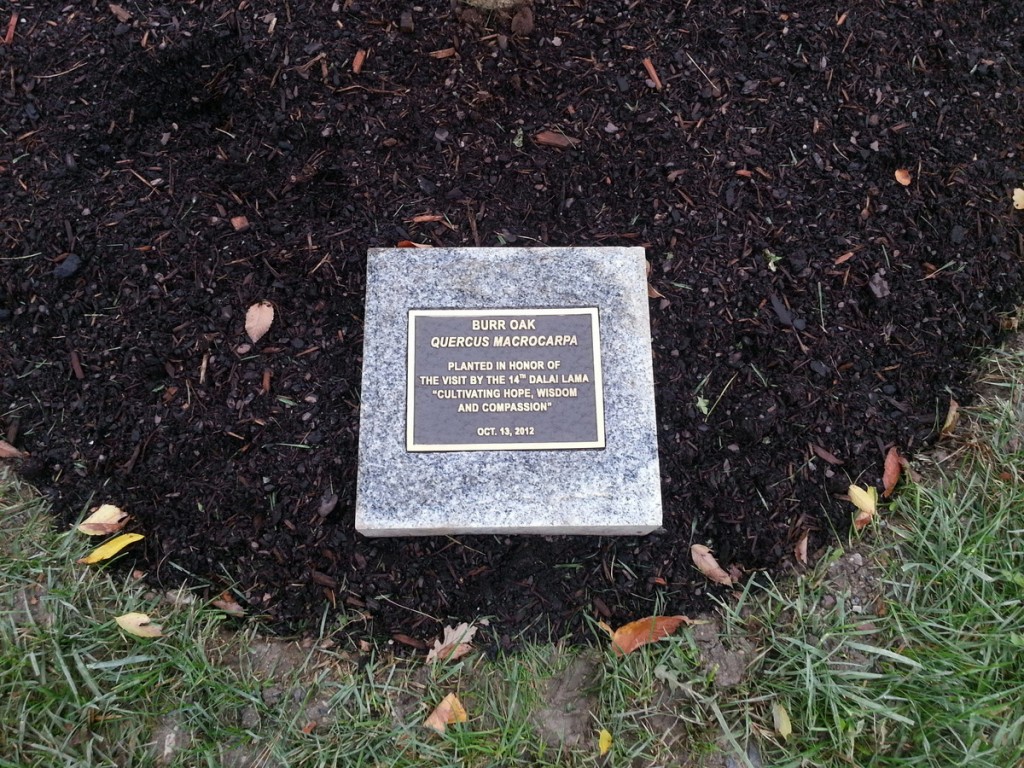
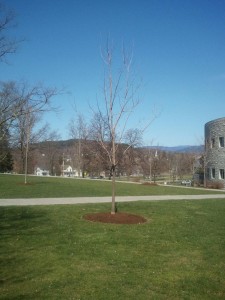
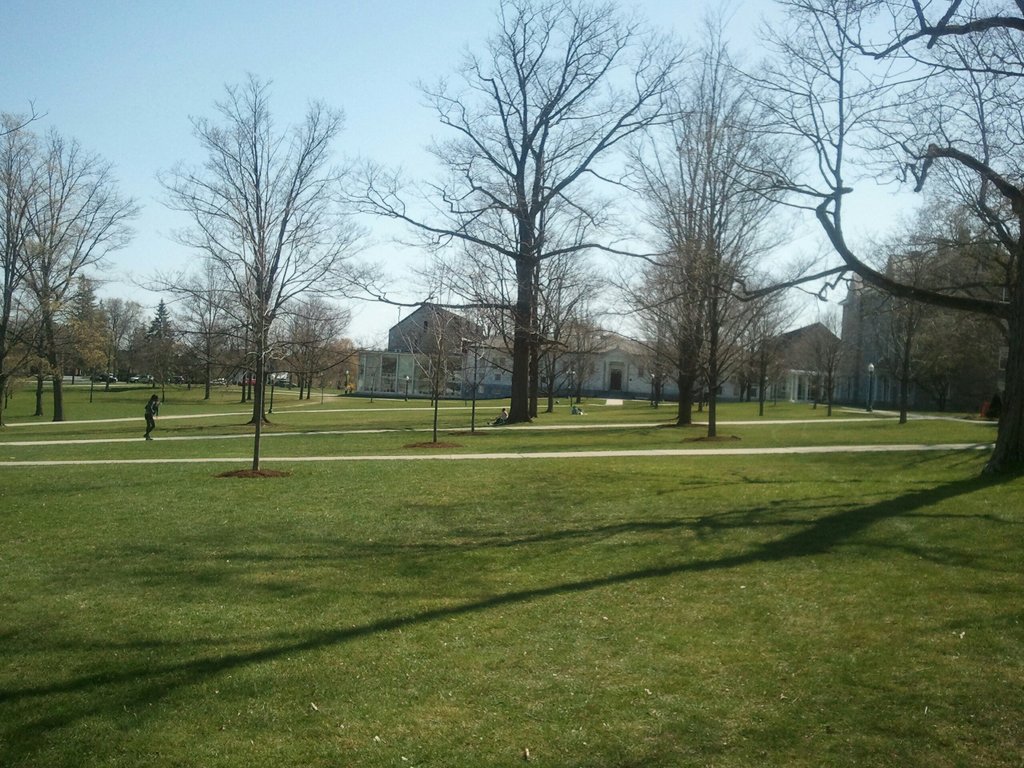
You must be logged in to post a comment.